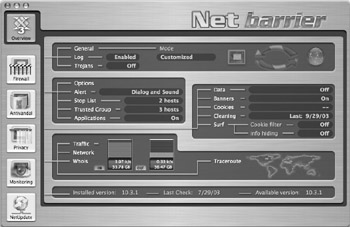Protect Your Mac from Network Intrusions
So far in this chapter, I’ve been talking about controlling physical access to your Mac—about keeping unwanted people from accessing your files by sitting down in front of your Mac and opening your files and folders. This section is about the other main security problems that affect computers: intruders, vandals, and hackers attacking your Mac over a network, either to disable it or to get copies of your files.
Unless you work for the CIA or the FBI, your files don’t interest that many people. Or do they? As surprising as it seems, industrial espionage is very common, and you may have competitors or even coworkers who would be interested in seeing some of your files. Some people might want to steal your identity, or personal information, so they can masquerade as you and use your credit card or other personal information for financial gain. Also, hackers may want to use your Mac as a relay to attack other computers. Finally, some hackers are just malicious, and get a kick out of doing damage to other people’s computers.
If you have a permanent connection to the Internet—a cable or DSL connection or other “always-on” connection—you should protect your Mac with a firewall application. This type of software keeps hackers out of your Mac and protects you from damaging attacks.
Your Mac comes with a built-in firewall, which is limited but efficient. Open the Sharing preference pane in the System Preferences and click the Firewall tab to access it. (See Figure 19-3.)

Figure 19-3: The Firewall tab of the Sharing preference pane lets you access the Mac OS X built-in firewall.
This firewall lets you block incoming traffic to all services other than the ones you enable. To activate this firewall, just click the Start button. Incoming network traffic to any services other than those you have turned on in the Services tab of this preference pane will be blocked. This is good protection, but it does not keep you safe from all kinds of hacker attacks.
You can start protecting yourself by not turning on any unneeded network services. I talk about sharing and network services in Chapter 12. If you don’t need to share files at all, don’t turn any of these services on. See Chapter 12 for an explanation of each of them.
In addition to the Mac OS X built-in firewall, several third-party programs offer additional protection. Beyond simply blocking network traffic, these programs can prevent many kinds of attacks and intrusions, let you set your own firewall rules, and offer monitoring functions as well.
The two main third-party firewall programs for Mac are Intego NetBarrier X3 (www.intego.com) and Norton Personal Firewall (www.symantec.com). Both these programs offer protection against the main types of attacks, but NetBarrier goes further, offering more than just firewall protection.

No matter which firewall you choose—whether you use the Mac OS X built-in firewall or a third-party product—remember that this type of application is only useful if it is correctly configured. If you configure it incorrectly, you may open your Mac up to possible intrusions, but you may also make it more difficult for you to use the Internet or another network.
EAN: 2147483647
Pages: 171